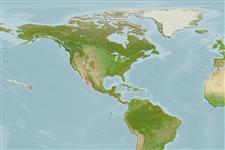>
Eupercaria/misc (Various families in series Eupercaria) >
Haemulidae (Grunts) > Haemulinae
Etymology: Haemulon: Greek, haimaleos = bloody (Ref. 45335).
More on author: Gill.
Environment: milieu / climate zone / depth range / distribution range
Ecologie
marien rifbewoner; diepte 3 - 30 m (Ref. 5227), usually 10 - 12 m (Ref. 5227). Tropical; 28°N - 7°N
Eastern Central Pacific: Gulf of California to Panama.
Grootte / Gewicht / Leeftijd
Maturity: Lm ? range ? - ? cm
Max length : 71.0 cm TL mannelijk / geslacht onbekend; (Ref. 55763); common length : 30.0 cm TL mannelijk / geslacht onbekend; (Ref. 55763); max. gepubliceerd gewicht: 2.3 kg (Ref. 40926)
Korte beschrijving
Determinatiesleutels | Morfologie | Morfometrie
Body oblong, compressed and not very deep (depth contained 2.9 to 3.3 times in standard length ); mouth large and terminal, its posterior end located under the anterior rim of the eye; first gill arch with 18 to 22 gill rakers; dorsal fin notched, with 11 to 12 spines and 16 to 18 soft rays (XI-XII, 16-18); second anal spine slightly longer and stronger than third; scale series above lateral line oblique; juveniles with 3 vertical bars and a caudal spot that disappears with age; adults with 6 or 7 dark gray vertical bars on a yellowish body; head with a dark spot behind the eye (Ref. 55763).
Forms schools in coastal reefs during the day but disperses at night in search for food. Often feed by digging in sand (Ref. 5227).
Levenscyclus en paargedrag
Maturities | Voortplanting | Spawnings | Egg(s) | Fecundities | Larven
Oviparous, distinct pairing during breeding (Ref. 205).
McKay, R.J. and M. Schneider, 1995. Haemulidae. Burros, corocoros, chulas, gallinazos, roncos. p. 1136-1173. In W. Fischer, F. Krupp, W. Schneider, C. Sommer, K.E. Carpenter and V. Niem (eds.) Guia FAO para Identification de Especies para lo Fines de la Pesca. Pacifico Centro-Oriental. 3 Vols. FAO, Rome. (Ref. 9114)
Status op de Rode Lijst van het IUCN (Ref. 130435)
Gevaar voor de mens
Harmless
Gebruik door de mens
Visserij: van minder commercieel belang
Tools
Speciale rapporten
Download XML
Internetbronnen
Estimates based on models
Preferred temperature (Ref.
123201): 22.9 - 29.1, mean 28 °C (based on 149 cells).
Fylogenetische diversiteitsindex (Ref.
82804): PD
50 = 0.5000 [Uniqueness, from 0.5 = low to 2.0 = high].
Bayesian length-weight: a=0.02512 (0.01488 - 0.04240), b=3.02 (2.88 - 3.16), in cm total length, based on LWR estimates for this species & Genus-body shape (Ref.
93245).
Trofisch niveau (Ref.
69278): 4.2 ±0.73 se; based on food items.
Generation time: 8.3 ( na - na) years. Estimated as median ln(3)/K based on 1
growth studies.
Weerstandsvermogen (Ref.
120179): laag, minimale populatieverdubbelingstijd 4,5-14 jaar (K=0.13).
Fishing Vulnerability (Ref.
59153): High vulnerability (58 of 100).
Nutrients (Ref.
124155): Calcium = 26.6 [9.7, 51.1] mg/100g; Iron = 0.52 [0.26, 0.95] mg/100g; Protein = 19.4 [17.5, 21.2] %; Omega3 = 0.118 [0.064, 0.199] g/100g; Selenium = 30.9 [16.3, 56.9] μg/100g; VitaminA = 121 [44, 318] μg/100g; Zinc = 0.879 [0.599, 1.285] mg/100g (wet weight);
